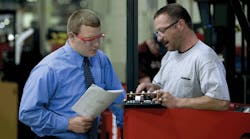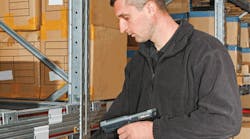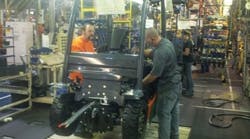Companies can pay anywhere between $15,000 and $50,000 for a new lift truck. That’s the price they pay, but the real question is, what’s the cost they bear? Many don’t realize that more than 70% of that cost is in who they put behind the wheel. Labor drives lift trucks and their costs. That’s why you’ll never know what your lift trucks cost unless you crunch the numbers they generate.
Most lift truck providers have made a business out of offering the necessary equipment and services necessary to capture and analyze those numbers. It’s become such an important part of their business that the lift truck itself is no longer the focus of a sale. What you’re buying is what you want to accomplish with it. And your main investment starts with who you hire to operate the equipment.
Scott Craver wanted to make that message crystal clear during the webcast he hosted with MH&L earlier this week (now available online). He’s product manager for business and information solutions at The Raymond Corporation. His title alone tells you where the lift truck industry is heading. And during the Q&A period after his presentation, Craver got the opportunity to demonstrate how he earned it. Someone listening in on the presentation was more interested in how he could improve operator performance rather than just measure it. Craver jumped at that opportunity.
“This data can be used as a coaching tool,” he said. “Some customers post the data on the wall to shame some of their operators. That’s not a great way to build team morale, but it does get results. It also results in high turnover. We like to see these facilities use the data to coach and mentor their employees. That impact data, productivity data and utilization data should then become part of the operator’s annual review.”
And rather than using peer pressure to shame operators, he suggested, use fellow operators to help coach and incentivize for performance. He told of some clients who break their workforce into teams, and those teams are offered incentives to increase their productivity. Average operators are used as a baseline by which to coach and mentor people who are not up to the average.
“Year after year we’re finding our customers can ratchet up that minimum standard and achieve year after year improvement,” Craver said.
Improvements are both short- and long-term. Within the first month, according to Craver, you’ll see fewer impacts with racks and other objects. Those savings mount up quickly.
“Every dollar you spend in truck repairs is actually 10 times that in terms of product, rack and facility damage,” he added.
Just the system’s visibility on the truck is enough to have an effect. Craver told of the system his team installed at a greeting card company. This client found that just by installing the systems on the trucks and the operators having to log in, without even loading the software to monitor data, the company realized a five percent improvement in productivity the first month.
But as Craver said, operators are motivated by money, and they can be incentivized to improve that productivity significantly.
“Some of our customers are taking 25% of those productivity improvements and passing them back to the operators, pocketing the other 75% to their bottom line,” he explained. “In some cases those improvements are so substantial that operators are getting an extra $300 a month. That’s a car payment to many. Other places offer gift cards, monthly recognition and peer recognition to motivate them to be top performers.”
That’s good information to have in case your company’s bean counters need an incentive to approve your next lift truck purchase.





